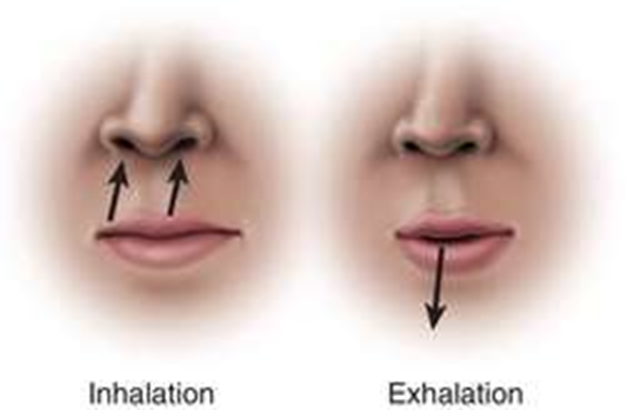When teaching a client how to perform pursed lip breathing, which instructions would the nurse include? (Select all that apply)
Lean on your back with your knees bent.
Use your abdominal muscles to squeeze air out of your lungs.
Breathe out slowly without puffing your cheeks.
Focus on inhaling and holding your breath as long as you can.
Exhale at least twice the amount of time it took to breathe in.
Open your mouth and breathe deeply.
Correct Answer : B,C,E
Choice A: Lean on your back with your knees bent.
Reason: This instruction is incorrect. Pursed lip breathing is typically performed in a seated position with the neck and shoulders relaxed. Lying on your back with knees bent is not a recommended position for this breathing technique.
Choice B: Use your abdominal muscles to squeeze air out of your lungs.
Reason: This instruction is correct. Using the abdominal muscles helps to expel air more effectively from the lungs, which is a key component of pursed lip breathing. This technique helps to improve ventilation and reduce the work of breathing.

Choice C: Breathe out slowly without puffing your cheeks.
Reason: This instruction is correct. Breathing out slowly through pursed lips without puffing the cheeks helps to keep the airways open longer, allowing more air to be expelled from the lungs. This technique is particularly beneficial for individuals with chronic obstructive pulmonary disease (COPD) or other respiratory conditions.
Choice D: Focus on inhaling and holding your breath as long as you can.
Reason: This instruction is incorrect. The focus of pursed lip breathing is on controlled exhalation rather than holding the breath. Inhaling should be done slowly through the nose, and exhaling should be prolonged through pursed lips.
Choice E: Exhale at least twice the amount of time it took to breathe in.
Reason: This instruction is correct. The exhalation phase should be longer than the inhalation phase, typically taking at least twice as long. This helps to improve the efficiency of breathing and reduce shortness of breath.
Choice F: Open your mouth and breathe deeply.
Reason: This instruction is incorrect. Pursed lip breathing involves breathing in through the nose and exhaling through pursed lips. Opening the mouth and breathing deeply is not part of this technique.
Nursing Test Bank
Naxlex Comprehensive Predictor Exams
Related Questions
Correct Answer is A
Explanation
Choice A: He is NPO until the speech-language pathologist performs a swallowing evaluation.
This is the most appropriate response. NPO stands for “nil per os,” which means nothing by mouth. After a stroke, it is crucial to assess the patient’s ability to swallow safely to prevent aspiration, which can lead to pneumonia and other complications. A speech-language pathologist is trained to evaluate swallowing function and determine the safest diet for the patient. Until this evaluation is completed, the patient should not consume any food or liquids.
Choice B: Be sure to sit him up when you are feeding him to make him feel more natural.
While sitting the patient up during feeding is important to reduce the risk of aspiration, it is not sufficient on its own. Without a proper swallowing evaluation, feeding the patient could still pose significant risks. Therefore, this choice is not the most appropriate response.
Choice C: You may give him a full-liquid diet, but please avoid solid foods until he gets stronger.
A full-liquid diet might seem like a safer option, but without a swallowing evaluation, there is still a risk of aspiration. The patient’s ability to handle even liquids needs to be assessed by a professional before any oral intake is allowed.
Choice D: Just be sure to add some thickener in his liquids to prevent choking and aspiration.
Thickening liquids can help manage dysphagia, but this should only be done after a swallowing evaluation has determined the appropriate consistency. Administering thickened liquids without an evaluation could still result in aspiration if the patient has severe swallowing difficulties.
Correct Answer is ["A","B","C","D"]
Explanation
Choice A reason: Monitoring the heart rate is crucial when administering amiodarone, as this drug can cause bradycardia (a slower than normal heart rate). Amiodarone affects the electrical conduction system of the heart, and close monitoring helps ensure that the heart rate remains within a safe range. The normal resting heart rate for adults is typically between 60 and 100 beats per minute.
Choice B reason: Respiratory rate monitoring is essential because amiodarone can cause pulmonary toxicity, which may manifest as interstitial pneumonitis or pulmonary fibrosis. Early detection of respiratory changes can help prevent severe complications. The normal respiratory rate for adults is 12 to 20 breaths per minute.
Choice C reason: Monitoring heart rhythm is necessary because amiodarone is used to treat arrhythmias, and it can also cause new arrhythmias or exacerbate existing ones. Continuous ECG monitoring helps detect any abnormal rhythms early, allowing for prompt intervention. Normal sinus rhythm is characterized by a regular rhythm with a rate of 60 to 100 beats per minute.
Choice D reason: Cardiac output monitoring is important because amiodarone can affect the contractility of the heart and overall cardiac function. Cardiac output is a measure of the amount of blood the heart pumps in one minute, and it is crucial for ensuring adequate tissue perfusion. Normal cardiac output ranges from 4 to 8 liters per minute in adults.
Whether you are a student looking to ace your exams or a practicing nurse seeking to enhance your expertise , our nursing education contents will empower you with the confidence and competence to make a difference in the lives of patients and become a respected leader in the healthcare field.
Visit Naxlex, invest in your future and unlock endless possibilities with our unparalleled nursing education contents today
Report Wrong Answer on the Current Question
Do you disagree with the answer? If yes, what is your expected answer? Explain.
Kindly be descriptive with the issue you are facing.
